The Record Store Years (Side Trip): Led Zeppelin and The Fairport Connection Pt. 2: One Night In L.A.
A memoir of 25 years (1975-2000) spent working in the world of records & music in Seattle, with occasional side trips into writings on Led Zeppelin and other adventures from my musical life.
This piece was originally published in issue #23 of my Zep fanzine Proximity in October 1996 as a companion “Concert Review” to the main article about Fairport & Zep’s connection that comprises part one of this Side Trip. For those interested in more details about Fairport Convention, I highly recommend the Patrick Humphries biography Meet On The Ledge from 1982, and more recently Andrew Hickey’s terrific podcast A History of Rock Music in 500 Songs - https://500songs.com/podcast/song-178-who-knows-where-the-time-goes-by-fairport-convention-part-one-going-electric/
One Night In L.A.
Fairport Convention’s best known and most influential music was created during the brief period in the late ‘60s when Sandy Denny was in the band, producing three studio albums over which the concept of traditional British folk music played in a rock band setting was developed. Following their acknowledged 1969 masterpiece Liege and Lief, Sandy and founding member and bassist Ashley Hutchings chose to leave the band. Denny started the band Fotheringay with her husband Trevor Lucas and later went on to a successful solo career, and Hutchings continued to explore traditional folk with Steeleye Span and The Albion Band.
Amazingly, the late ‘60s lineup of Fairport never made it to the United States. Sandy was reluctant to travel (she hated flying) which made touring a challenge, and their records hadn’t made much of a dent in the charts Stateside despite generally positive reviews and a modicum of promotion from their US label A&M.
Accustomed as they were to lineup changes, the remaining members – Richard Thompson, Simon Nicol, Dave Swarbrick and Dave Mattacks - chose to keep going but all agreed that there was no point in trying to replace Sandy with another female vocalist. However a new bass player was obviously needed, and it is at this point in the story that the Fairport-Zeppelin connection becomes the strongest: Enter Dave Pegg.
“Peggy” was an old mate of Swarbrick’s from his Birmingham days – and a bandmate of John Bonham’s during the same period. According to the band’s mentor and producer Joe Boyd, Swarb had to push to get the rest of the band interested in giving him an audition:
“There were already many candidates in mind, mostly from other groups. The general trend was toward real rock ‘n’ rollers. There was a feeling within the band that the folk music drift was great as a concept, but it had been a little unnerving to see their bass player spend hour after hour in the Cecil Sharpe House archives, pouring over old texts of ballads and listening to old tapes of unaccompanied singers, as Ashley had been doing. They wanted a real no-nonsense rocker.
There was a palpable mood of macho male assertion of the values of the road. There was going to be lots of touring, now that Sandy and her fear of flying was gone. So when Swarb mentioned his friend from Birmingham who played stand-up bass in the Ian Campbell Folk Group, everyone told him to mind his own business and leave the bass player selection to those in the band who understood such things. In vain, Swarbrick spoke of his friend’s love of heavy metal music and his friendship with various members of Led Zeppelin. ‘He can play electric bass really well, honest,’ said Dave. Finally, just to shut him up, they agreed to give this folkie an audition at the beginning of an afternoon of other auditions.
I arrived just after the trial started. They had decided to get rid of him quickly by taking off on “Tam Lin” at a brisker than usual tempo. They were into the final choruses by the time I poked my head in the door. Richard, Simon and even Mattacks from behind the drum kit were staring open-mouthed at Dave Pegg as he propelled them flawlessly, playing Ashley’s complicated bass lines with a power and accuracy even Ashley had never approached. So thus was the Full House lineup brought into being.”
Above: The Full House Lineup onstage, Summer 1970. Left to right: Dave Pegg, Richard Thompson, Dave Swarbrick, Dave Mattacks and Simon Nicol.
Although this incarnation of the band lasted only a year before yet another lineup change, they made one classic studio album in Full House (Island/A&M) and developed into a blistering live act in the process. After a handful of UK shows in early 1970, Fairport finally made it across the pond in the spring for a lengthy US tour supporting Traffic, Jethro Tull and others. They played the Fillmores on both coasts and most of the other prestigious rock venues of the day, as well as a week-long engagement at Doug Weston’s Troubadour club in Los Angeles in May supporting Rick Nelson and the Stone Canyon Band – a hot gig even for jaded LA – attracting luminaries such as Odetta, Maria Muldaur and Linda Ronstadt.
Back in England following the tour, Fairport performed on the same bill as Led Zeppelin for the first time, at the enormous Bath Festival on June 27 and 28.
Above: At left, a Fillmore East schedule ad including Fairport’s opening slot for Traffic on FC’s first US tour in June 1970, and on the right two pages from the Fillmore East program for their second tour booking in August – just a few days before their weekend at The Troubadour on the opposite coast.
Below: A poster for the Bath Festival where Fairport played between their two US trips and shared the bill with Led Zeppelin, and print ads for Fairport’s return to the Troubadour and Zeppelin’s show at the Forum on the same weekend.
Fulfilling the promise of ‘lots of touring,’ Fairport came back to the States in late summer for a second run which included a four-night return engagement as headliners at The Troubadour.
Across town, purely by chance, Led Zeppelin was on the home stretch of their sixth tour of North America in less than two years (you read that right - it’s “How The West Was Won”). They faced a crowd of some 20,000 people at the Los Angeles Forum as Fairport played to a far more intimate gathering of only a few hundred at The Troubadour. Both bands delivered inspired, peak performances, and both were captured for posterity on audio tape.
At the Forum, not one but two bootleggers were in action, unbeknownst to the band or their notoriously anti-bootleg manager Peter Grant. Amazingly, both tapers were using high quality reel-to-reel decks, one stereo and the other mono. Both recordings have been circulated and released as bootleg albums and CDs over the years, and the better of the two – the stereo one - stands as one of the earliest and most successful bootleg albums, Live On Blueberry Hill.
Over at the Troubadour, Fairport’s performances were being captured on professional 8-track recording equipment by engineer John Wood, under the auspices of producer Joe Boyd. The resulting recordings were eventually edited down to become the 1977 album Live At The L.A. Troubadour (Island), released only in England and Europe, and then later revamped in 1986 with some variations in material for release in the US, called House Full (Hannibal).
Blueberry Hill and House Full stand right up among the very best recordings by both of these bands. A unique combination of these musicians also occurred on the night of September 4th, 1970, and this too was captured on tape by John Wood and Joe Boyd. The Night Zeppelin Jammed With Fairport has been talked about for years, and the recording made – which has never seen the light of day – more or less constitutes a holy grail to collectors of both bands. While the tape supposedly resides deep in a vault and we may never get to hear it, our imaginations can be fueled with help from the various anecdotes related by eyewitnesses and participants in the event.
Above: On stage at the Forum, 9-4-70. (Photo by Eddie Vincent)
Following their triumphant two-and-a-half-hour show at the Forum, all four members of Led Zeppelin, manager Peter Grant and road manager Richard Cole showed up at the Troubadour in time to catch Fairport’s second set. Though Joe Boyd does not recall Bonham being present, Fairport drummer Dave Mattacks has described Bonzo’s trashing of his drum set at the Troubadour on more than one occasion, so we can perhaps assume that Boyd was so distracted by Peter Grant that he didn’t realize Bonham was playing!
In the liner notes for Fairport’s 1986 House Full album, Boyd recalled the event thusly:
“Late one night the fellow-members of the Birmingham Water Buffalo Club (some disgusting Midlands beer-drinking ritual is the membership requirement) Led Zeppelin fell by to destroy a few ballads and jigs. Swarbrick’s opening verse [to “Banks of The Sweet Primroses”] is drowned out on the tape by the dulcet tones of Zep’s soft-spoken manager, Peter Grant, remonstrating with the waitress who was trying to remove the beer bottles from his front row table. The music which followed was, like Grant’s oaths and the membership regulations of the BWBC, not fit for a family album, which this certainly is.”
Above: At least two of these men are members of the Birmingham Water Buffalo Club, and the rest appear fully prepared to undergo the disgusting ritual required for membership. (Zeppelin photo by Wolfgang Heilemann)
The musicians changed around a bit from song to song, Richard Thompson playing a Les Paul and Page using Simon Nicol’s hollow body Gibson L5, strung with heavy gauge strings that caused him some consternation and prompted him to remark afterwards, “It was like trying to play railway lines!” (Page is known for favoring ‘super-slinky’ light gauge strings).
Dave Mattacks not only got to hear how his drum kit sounded from the crowd, he had the dubious distinction of having to repair it and replace the heads after Bonzo gave it a sound thrashing. Simon Nicol recalled that “Mattack’s bass drum had been totally solid the whole night, but I saw it jump forward three or four inches on Bonzo’s first strike!”
Indulging in some tech-talk about drum tuning, Mattacks says, “When John played my drums there was very little distinction between my three toms. And although he was playing very hard, which does make a difference, my drums were [tuned] way too low. The drums just sounded soggy. I remember getting off stage, hearing him play and thinking, “Oh, they don’t sound very good.” He was beating the shit out of them; he played great but the drums didn’t sound too hot. I got back up and it was all my lovely Super Classics – heads all dented!”
With various combinations of musicians including Plant on vocals and Jones on bass, the heavy metal folk rock combo played a handful of tunes, including a jig that challenged Page, and some blues. Common ground was found with then-popular rock chestnuts like “Morning Dew,” Elvis’s “Mystery Train” and “That’s Alright Mama,” and Fairport’s own renditions of the traditional folk tune “Banks of The Sweet Primroses.”
And the 8-track mobile recording equipment was rolling the whole time, by some accounts capturing as much as three hours of music! The mind boggles. . .
As legend has it, the party continued on after the jam session. The after-hours joint Barney’s Beanery was nearby and became the site of a drinking contest involving Dave Pegg, John Bonham and Janis Joplin, who was likely found hanging out there - it was known to be one of her favorite haunts. I have not been able to fully substantiate this part of the story – it’s plausible but also smacks just a bit much of rock’n’roll mythology – but why let facts get in the way of a great tale, right? Oh, and Peggy won.
Joe Boyd: Eyewitness to the BWBC L.A. Reunion
At this juncture a few words about Joe Boyd are in order. While far from a household name, Boyd is a giant in the world of music – if you are unfamiliar with him, check his Wikipedia page or better yet, read his fabulous memoir White Bicycles. His involvement with Pink Floyd, Fairport Convention, Nick Drake, Richard Thompson and many, many other great and influential artists puts him in the pantheon with other behind-the-scenes greats like George Martin, Chas Chandler and Kit Lambert. In some ways Boyd eclipsed them all because he was equally astute in the business and creative sides of the music world.
In 1996 when I was putting this article together I reached out to Joe to ask if he could contribute any additional information as an eyewitness to the event. I was careful not to appear too enthusiastic about the long-buried tape, and he generously took the time to reply to me with the personal letter reproduced below. It gave us no hope for recovering the recording, but I’ve always been grateful for it.
One Night, Four Albums
There are essentially four different albums derived from the music of September 4, 1970: two unauthorized Led Zep releases, and two commercially released Fairport albums (three if you include an early 2000’s re-package).
The first bootleg of the Zeppelin show, and one of the earliest rock bootlegs to come out, was Led Zeppelin Live At The Los Angeles Forum 9-4-70 on the Rubber Dubber label. This double-LP was sourced from the mono recording of the show allegedly taped by Rubber Dubber himself, and the songs appear in random order, with all between-song patter cut and incorrect titles for some of the pieces from Zep’s yet to be released third album.
Next came Live On Blueberry Hill, originally on the Trademark Of Quality label and so named due to the band’s only known rendition of the Fats Domino hit, played as one of several deliriously received encores at the show. This album was sourced from the stereo tape and presented the songs in correct order, though some of the titles were still wrong and the album suffers from a serious lack of low frequencies in the mastering. Blueberry Hill has been “re-bootlegged” many, many times, usually under the same title and with inferior quality to the original release.
Finally in the early ‘90s both source recordings were released on CD with vastly improved sound quality and correct song titles, running order and with most of the patter restored. As with all bootlegs there are various different editions, but the definitive CD release in my opinion is the 4-disc Led Zeppelin Live On Blueberry Hill on the Last Stand Disc label, which presents both source tapes complete.
As for Fairport Convention, a single LP derived from the Troubadour shows came out as a UK-only release on Island Records in 1977, titled Fairport Convention Live at The L.A. Troubadour. After a few years the album went out of print, and was long a top item on Fairport collectors’ want lists.
In 1986 Joe Boyd oversaw the release of House Full on his Hannibal label, which included much of the original LP with a few different songs from the Troubadour shows, and it came out on both LP and CD in the United States. In the early 2000’s House Full was reissued on CD with a slightly different track arrangement and packaging.
All of the above are essential listening to my mind, and especially rewarding for those who love live concert recordings that really capture the feel of an event, as these do so well.
While it seems unlikely that the Zep-Fairport jam recording will ever come to the surface, stranger things have happened, and occasionally golden nuggets that have been buried for years continue to show up – witness the stellar film footage of Led Zeppelin from the 1970 Bath Festival that surfaced on YouTube a couple of years ago. Sometimes I fantasize about a box set of the complete Fairport Troubadour run – Zep jam included. It could be a 6-CD package with a deluxe booklet and liner notes by Joe Boyd. . . is anybody from Universal out there listening?
Next: Going Pro: Bags, Aprons & Name Tags

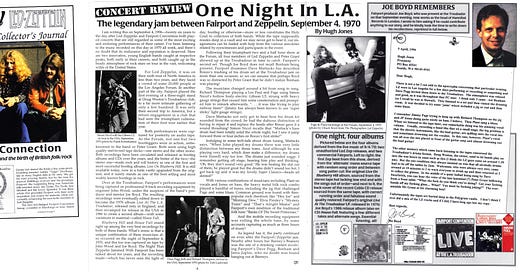




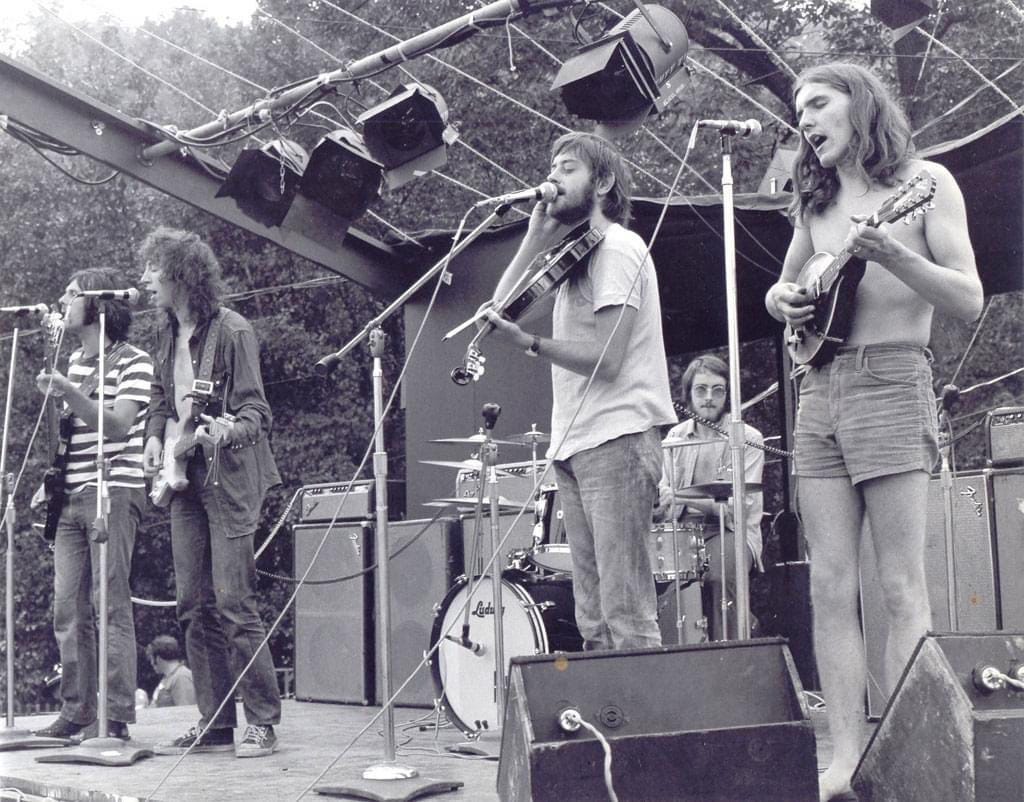
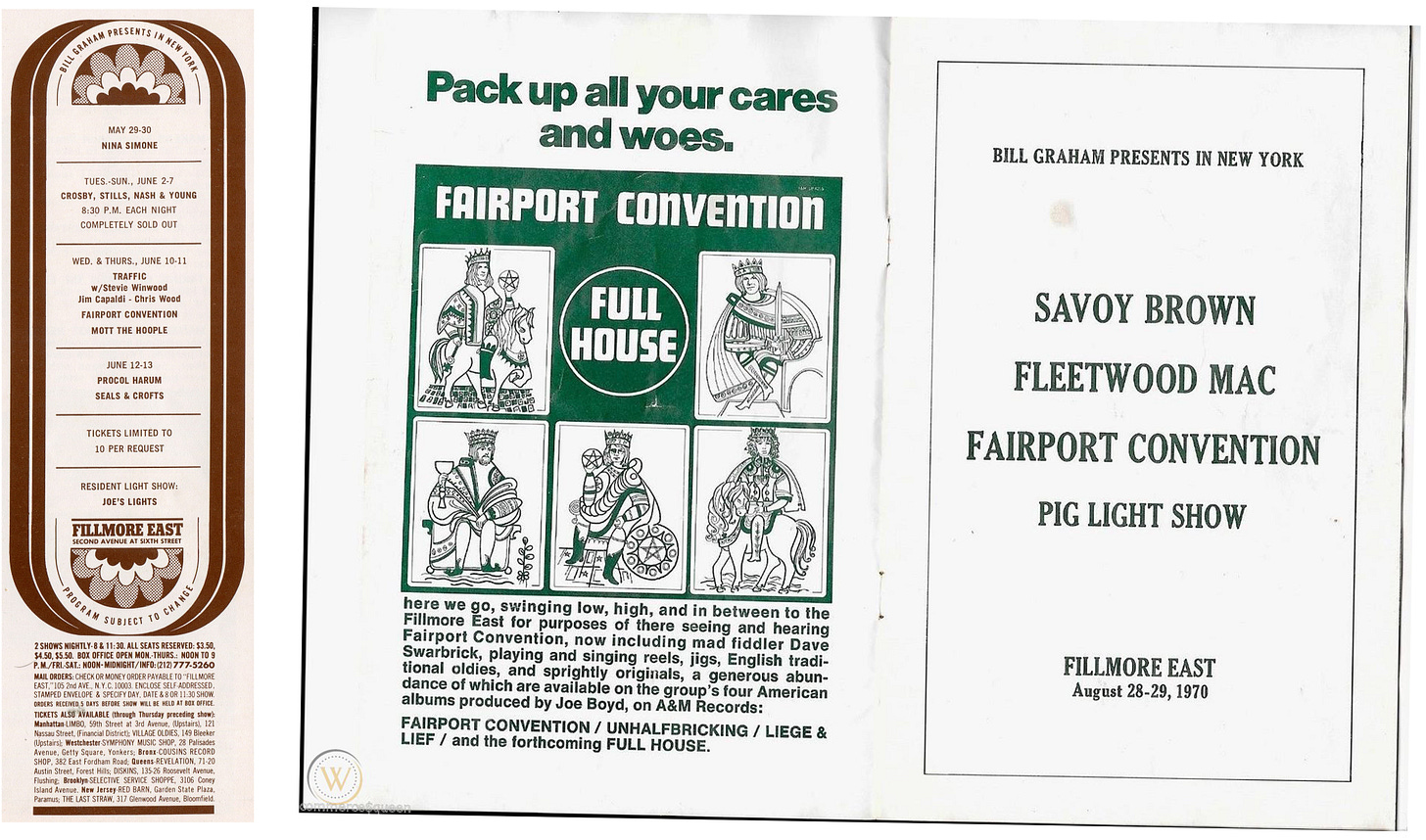
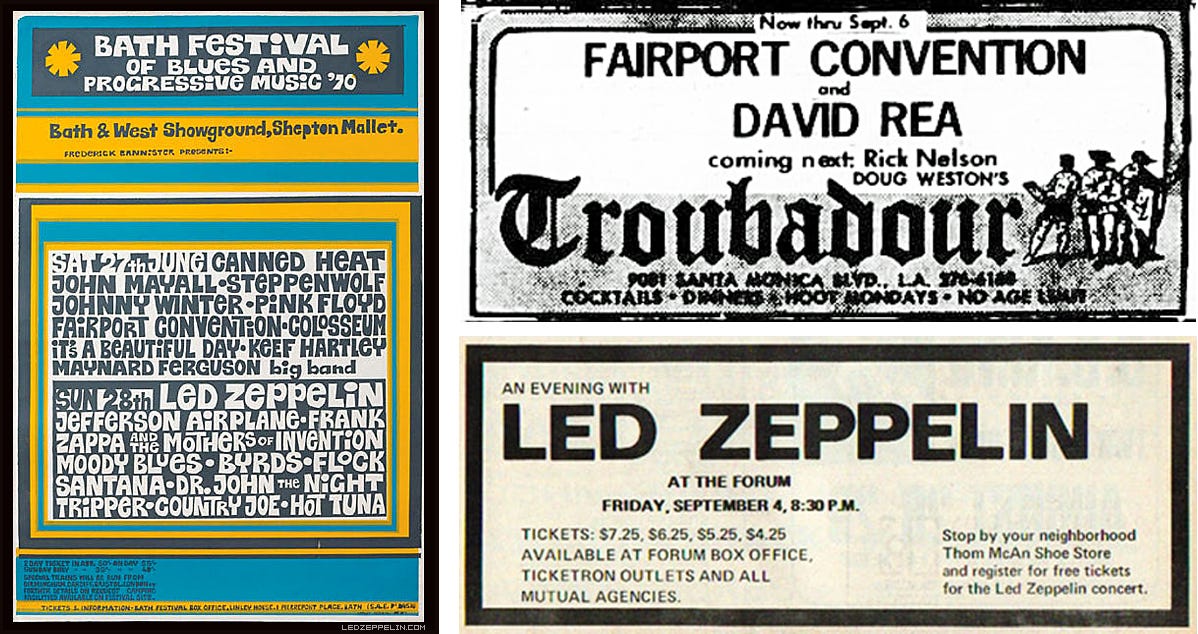
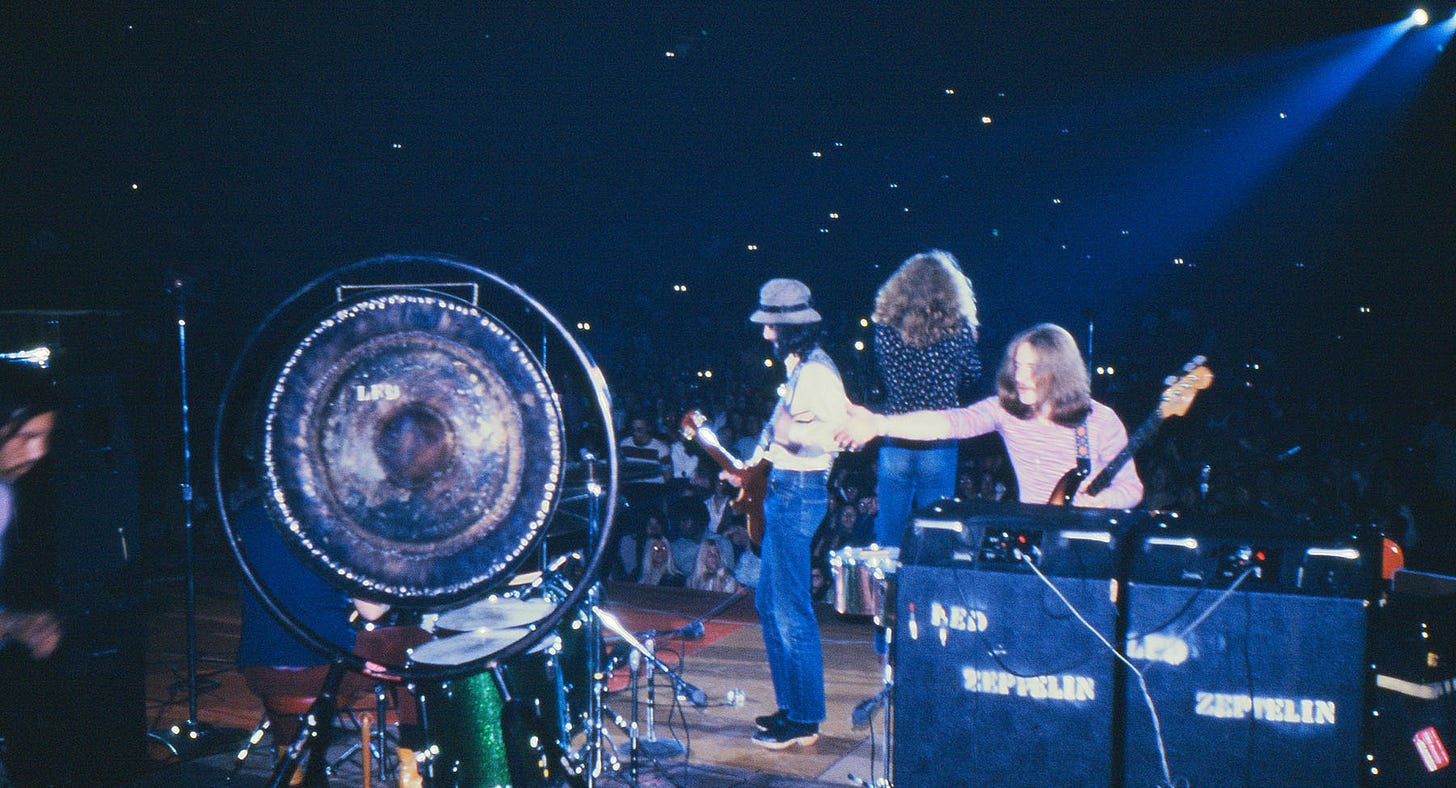

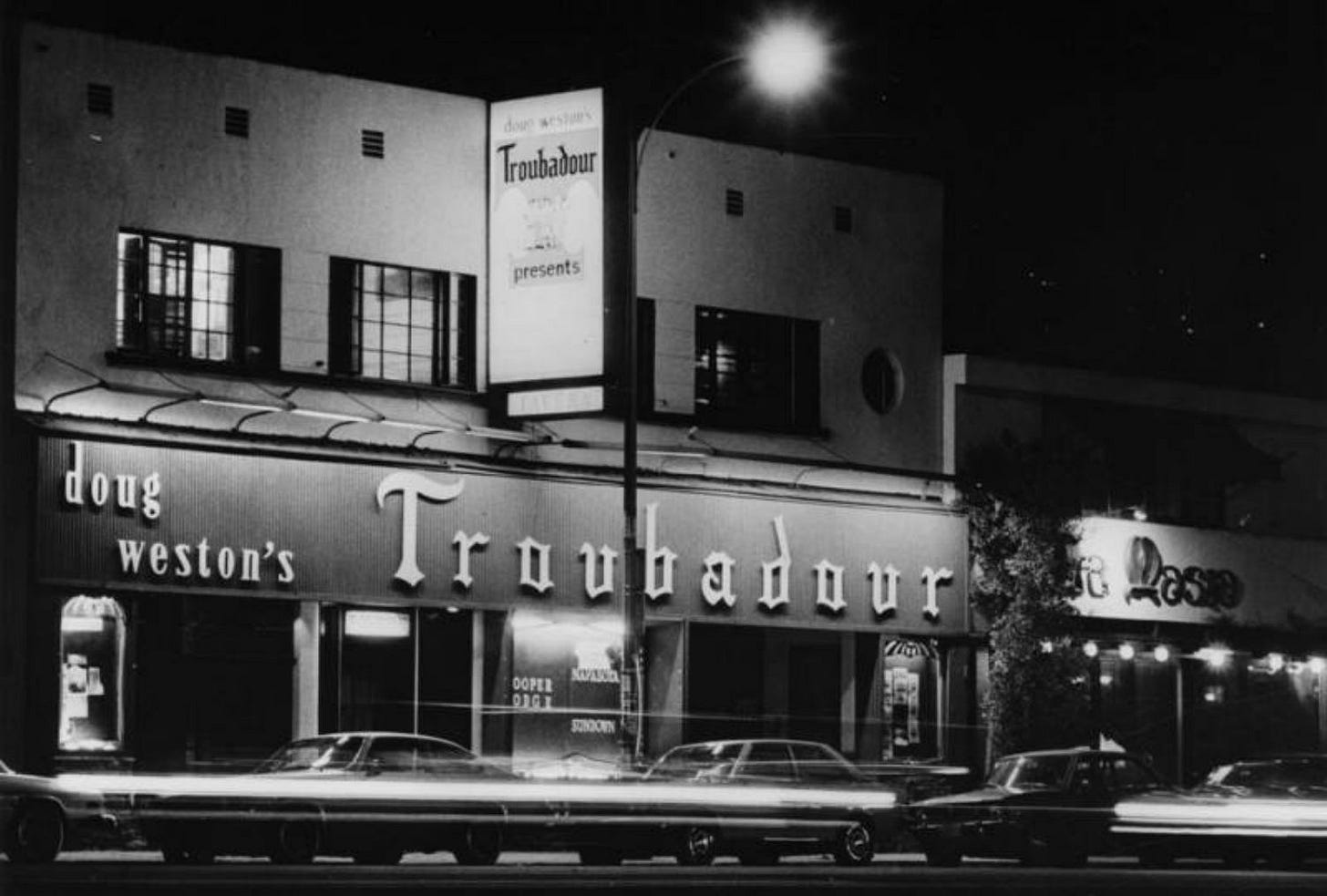
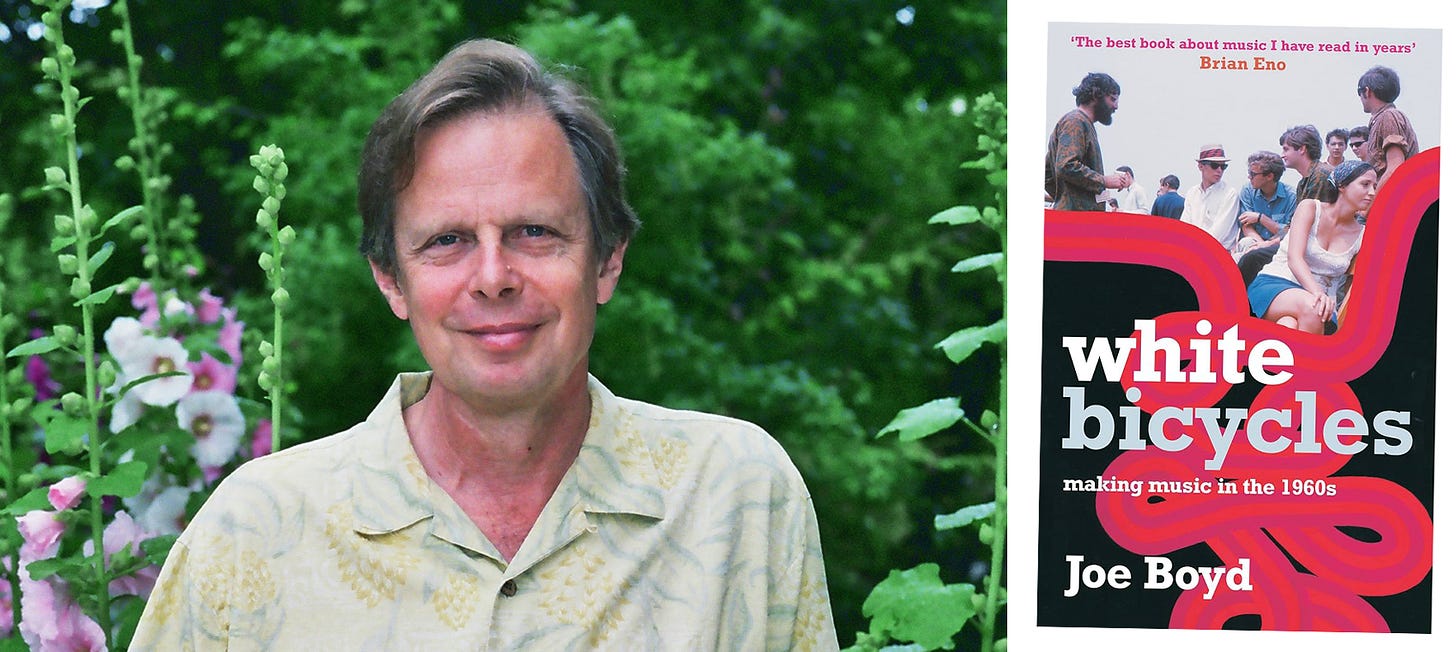
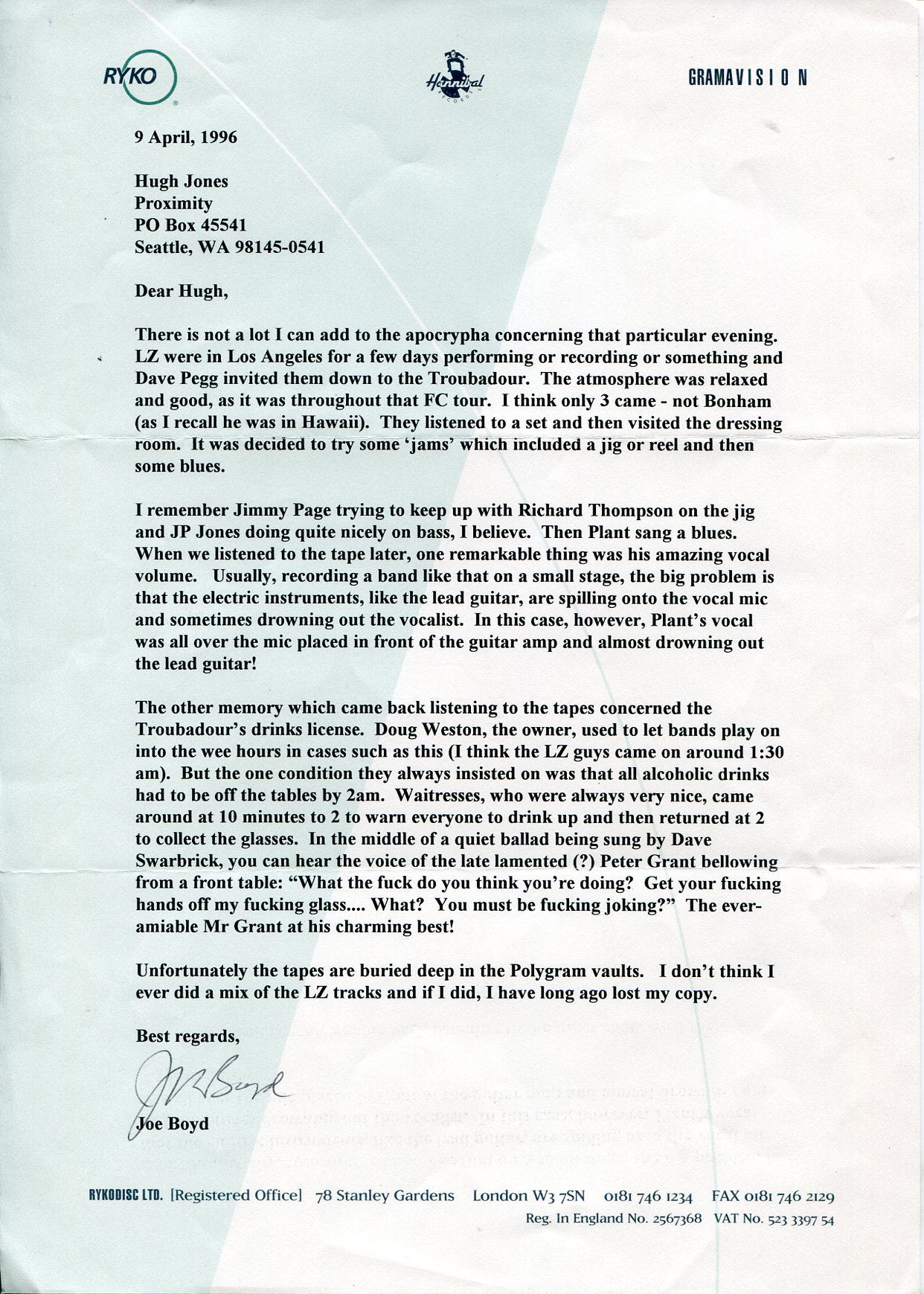
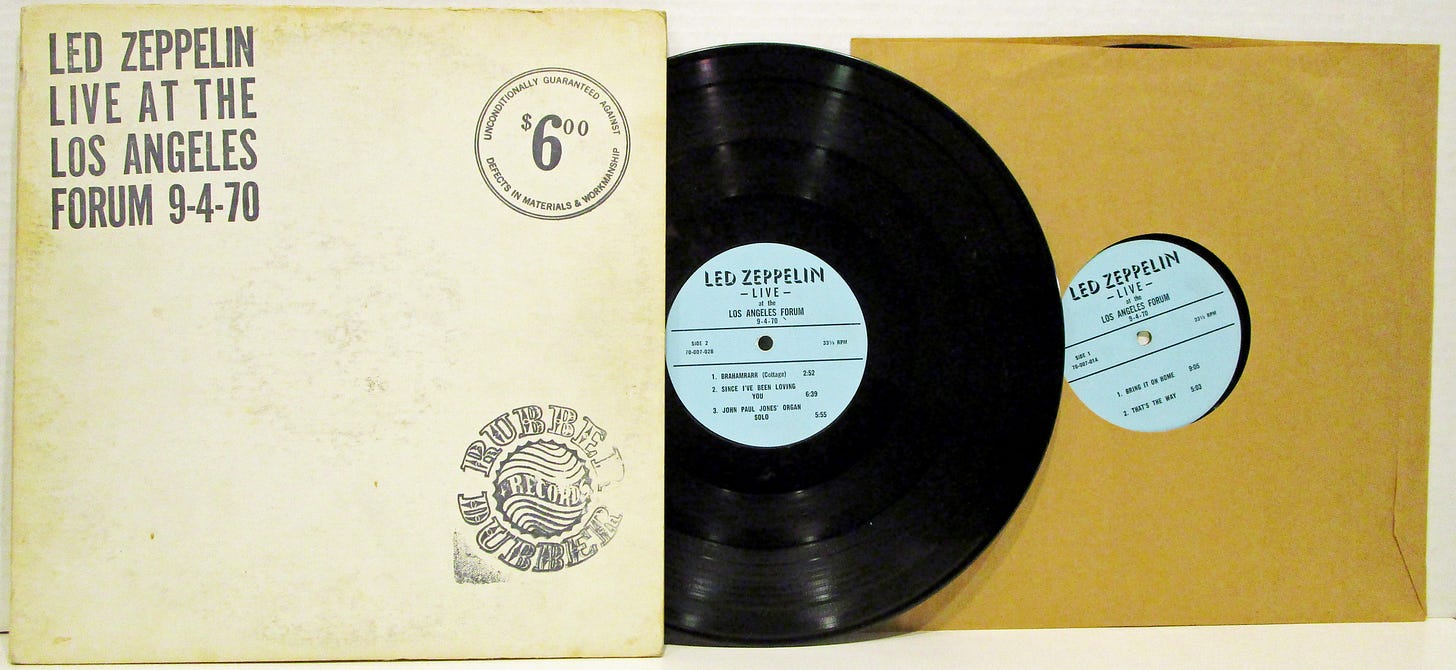



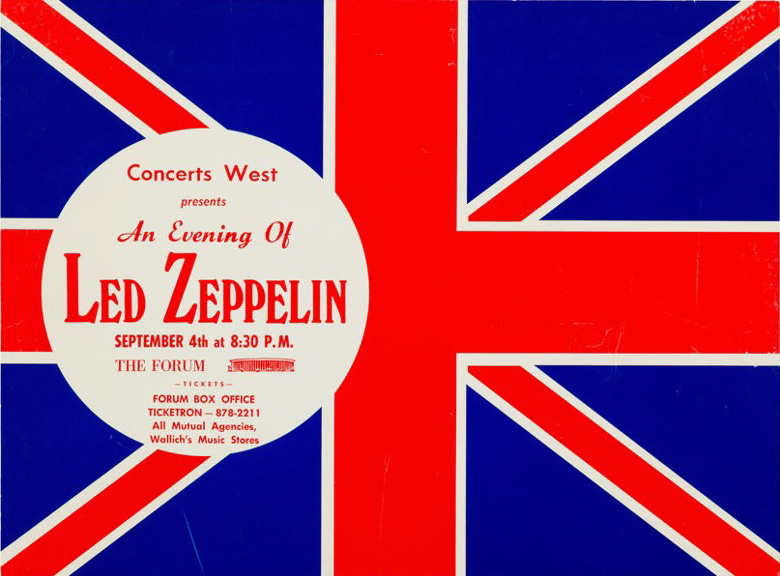
Another really interesting post, Hugh.
About the lost recording, Polygram became part of Universal, which had an enormous fire in 2008. I saved a post about that but can't find it now. It seems many original recordings were lost, far more than the company would admit as of course lawsuits ensued. There was also the problem that the recordings were not well-archived or labeled so it wasn't clear what was in there and what irreplaceable recordings went up in smoke. So the LZ-FP recording could possibly have been there, or it could be in someone's private collection! Here's the wiki entry on the fire -- https://en.wikipedia.org/wiki/2008_Universal_Studios_fire
That is a bunch of interesting stories; I didn't really know about that era of Fairport Convention.